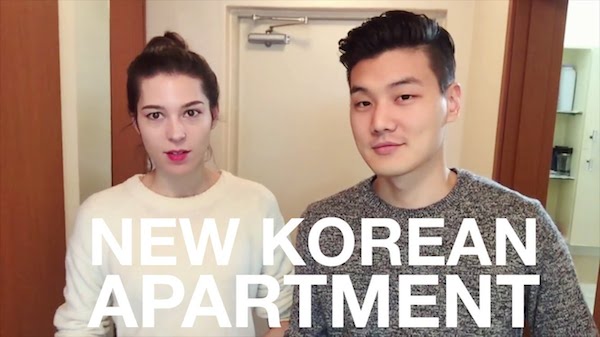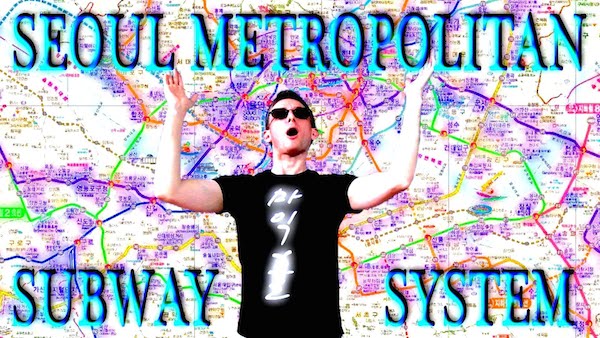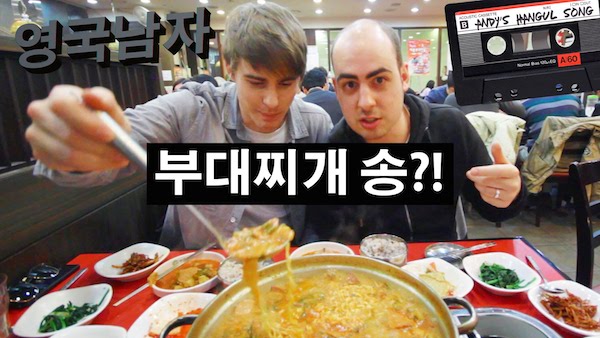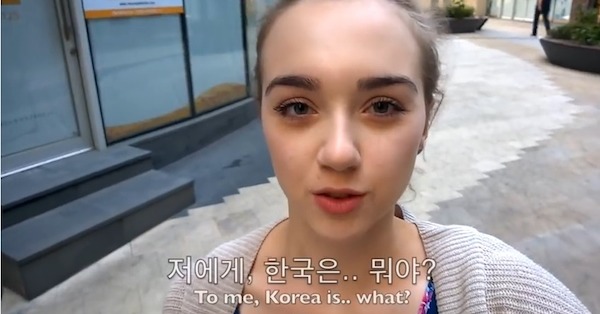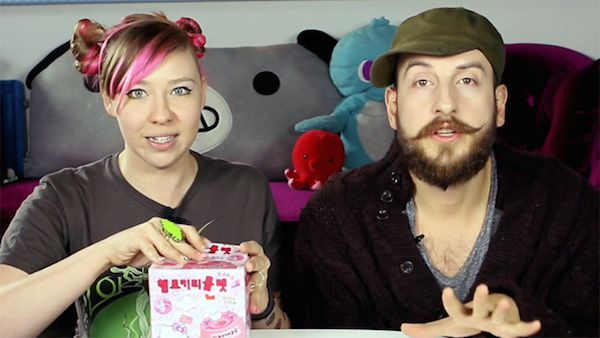A few weeks before moving from Los Angeles to Seoul, I went to a show at the Downtown Independent put on by Eat Your Kimchi. The word “show” doesn’t quite capture the nature of the event, but then I don’t know quite how to describe Eat Your Kimchi either. The project, the creation of a Canadian married couple called Simon and Martina Stawski, produced years of Youtube videos after brief Youtube videos about food in Korea, pop culture in Korea (their biggest hit being a tongue-in-cheek exegesis of “Gangnam Style”), and life in Korea as a foreigner. When EYK’s popularity blew up in a big way, it afforded its creators the opportunity to crowdfund a real live studio in one of Seoul’s hipper neighborhoods, its logo a beacon to all those expatriates harboring their own dreams of professionalized Korea vlogging.
If 21st-cetury media endeavors live or die by how well they connect with their fan base, EYK struck me in that moment as one of the halest, heartiest 21st-cetury media endeavors going: they’d almost filled the theater, and while the Downtown Independent isn’t exactly the Hollywood Bowl, I’d never seen a Youtube celebrity of any kind do it before. But then, the Simon and Martina Stawskis of the world have redefined the very nature of celebrity, a word that may once have identified only those known by nothing more than name and face to tens of millions, but has now expanded to cover those known much more intimately (if still indirectly, and even if the economics sucks) by thousands or even hundreds.
It stands to reason, then, that these new kinds of celebrities, making their new forms of entertainment, would require a new form of live performance, or rather live appearance, or rather something else intriguingly in-between. Like many events I’ve attended, EYK’s included a question-and-answer session; unlike any other event I’ve attended, EYK’s began with it, and in fact it took up most of the time we all spent there. (I didn’t stay for the post-event fan photo sessions which, for all I know, may well run deep into the night.) Even before Simon and Martina began taking questions, people started lining eagerly up at the microphone, allowing me observe one salient detail of EYK demographic: it’s all women.
Well, one man did eventually get in line, but he prefaced his question by saying that his wife had brought him there. This broadly aligns with what I’ve seen of the Korea vlogging world in general which, while not one hundred percent female, definitely skews that direction, whereas the actual long-term foreigner population I encounter here in Seoul skews precisely the opposite direction. Male Korea vloggers do exist, but from what I’ve seen, female Korea vloggers occupy the majority of the high-profile spots. And several of the men I’ve seen hosting Korea vlogs do it, like EYK, as one member of a hosting couple — sometimes their wives, in other words, have brought them there.
I found out about one such Korea-vlogging husband and wife through the documentary shows about foreigners I watch on EBS, more or less the Korean PBS. One episode of 한국에 산다 (They Live in Korea, as I might translate it) focused on the life of Sarah from Canada and Kyuho from Korea, who do their thing on Youtube under the banner of 2hearts1seoul, whose popular episodes include their wedding ceremony, the story of how they met, and the story of how Kyuho proposed. Far from Seoul out in the countryside resides another multicultural Korea-vlogging couple, the Australian Nicola and the Korean Sun-hong, who do the series My Korean Husband. They, too, have told their meeting story to the internet, and have much else besides to say on the subject of love: how to get a Korean boyfriend, things to consider when dating or marrying a Korean guy, how a Korean man should introduce his foreign girlfriend, the differences in dating culture between Korea and Australia, and so on.
Their videos give a sense of the standard forms this sort of vlogging has found so far: sometimes the hosts sit down and recount their experiences straight at you, chopped up by jump cuts (a few bloopers strategically left in) and accompanied by an often ukulele-driven score; sometimes you get fragments of their experiences out and about, cut together after their capturing with a handheld (or selfie stick-mounted) camera. Certain expected episode types have also emerged, such as the tour — if we can use the word, given the small size of the dwellings here — of the host’s Korean apartment: 2hearts1seoul have done one, and Eat Your Kimchi did at least four of them. (A vlogger named Cory May, for whose detailed urbanistic explorations of Seoul I tune in, once posted a tour of an apartment that looks eerily similar to mine. Then again, most of the apartments I’ve seen in the city look pretty much the same.)
The rest of the body of Korea vloggers have collectively shot what comes to a staggeringly, hypnotically long duration of apartment-touring (over the course of which you’ll hear hours of talk about the number pads we futuristically use instead of keys), including one lady known as Smiling Seoul, who made three, and Chelsea Speak, who’s done two so far. Both of them have also put out their own variations on another less common but more telling type of Korea vlogging episode: the elaborate apology and/or self-justification for not speaking more Korean despite having lived for years on the very peninsula that uses it. (Some try to bridge the gap with sheer exuberance, to mixed results.) Smiling Seoul called hers “Why I Don’t Speak Korean,” Chelsea Speak called hers “Why I Don’t Speak Korean,” and both attest, by their very existence, to the fraught relationship between Korea-resident Westerners and the language that surrounds them.
Michael Aronson, representing the male Korea vloggers, has also done a somewhat askew version of that standard, though he packs much more weirdness into his minute-long standoff with a whining pile of kimchi. Sheer oddity has made that into his second-most-viewed video, albeit a distant second to the Seoul Subway Song, a rap that incorporates both Aronson’s thorough knowledge of the conveniences of the capital’s rail system and the jingle that plays over its trains’ speakers whenever they approach transfer stations. It may not have got him anointed with honorary Seoul citizenship by itself, but alongside his raps on the Korean alphabet and traditional Korean clothing, and songs “I’m in Korea” (to the tune of “I’m a Believer”) and “Kimbap” (to the tune of “MMMBop”), it couldn’t have hurt. (He more recently joined the chorus of mockery against the city’s new slogan “I.Seoul.U” with a parody of “I Touch Myself,” but I doubt they’ll revoke his status for it.)
Other Korea vloggers have no need to dedicate episodes to explaining their infrequent use of Korean, because they use it all the time. A highly self-Koreanized American named Dave — or rather 데이브, Deibu — has used it to win a sizable Korean audience with comedic videos on the differences between boys and girls, between the linguistic habits of foreigners with four months in Korea and foreigners with four years, and between the tastes of chocolate and ramen (which he eliminates by mixing them together). An Australian named Sara (not to be confused with the aforementioned Canadian Sarah or Australian Nicola) has, with her channel SeoulSarang (sarang meaning love), narrated in Korean videos of her trips to Seoul Fashion Week at the Dongdaemun Design Plaza, Jeju Island, and even her native Sydney.
The prospect of hearing an Australian city described by a genuine Aussie in Korean had intrigued me, but Sara chose to conduct that episode, a food tour, almost wordlessly. Despite that, and despite having been shot far outside Korea, it somehow captured perhaps the most important common quality of Korea vlogs, or indeed, perhaps vlogs in general: a near-fetishistic fixation on things edible (which, in the case of at least one Korean vlogger, has crossed the line straight into fetishism, or the satire thereof). The internet, of course, has come to love food, possibly because, though its capabilities for conveying imagery and description of it food richer by the day, it still gets you no closer to the actual taste; eating remains one of the few experiences for which digital technology can offer no substitute (not that at least one Korean isn’t working on it as we speak).
But even Percival Lowell saw in the 19th century that Korean life revolves, to a possibly unique degree, around food, a cultural condition to which many more foreigners have since thrilled. And so no Korea vlogger can avoid doing food episodes, and few can avoid doing a lot of them. Eat Your Kimchi made a big part of their name on not just episodes involving the titular fermented cabbage, but Korean ramen, Korean fried chicken, and Korean pizza (not to mention a seemingly endless array of packaged snack tasting videos). 2hearts1seoul have covered street food, kimchi pancakes, and a buffet. My Korean Husband, on breaks from giving relationship advice, shift their focus to things like spicy noodles, spicy rice cakes, and the biggest piece of fried pork ever. 데이브, in addition to his chocolate ramen, has with his coterie of international pals consumed chicken neck soup, mozzarella burgers, and even spicier rice cakes before the camera.
Noe Alonzo’s ROK On!, which I especially enjoy for its occasional episodes in Spanish (a language I study whenever Korean gets to be too much), spends a great deal of time on food even by these standards: there you can see the pork spine soup known as gamjatang (감자탕) up close and hear about it in both English and Español. Josh the “Korean Englishman,” known for the solidity of both his language skills and production values, found a way to continue Korea vlogging even after he returned to his homeland: he now shoots the reactions of his countrymen to various Korean foods. He’s fed his fellow Brits things like Korean barbeuce, kimchi fried rice, and — with a staggering 5.6 million views — that beloved dish of Korean tradition, fried chicken and beer.
If the foreign vloggers of Korea have covered much the same ground as one another, they haven’t done it out of a lack of awareness of one another’s existence. Just as 21st-century media-makers have to connect to their fans, they have to connect to each other. And not only do Korea vloggers connect to each other, they tend to pop up on each other’s vlogs, as when 데이브 and the Korean Englishman had a pronunciation showdown, Sara from SeoulSarang joined Nicola and Sun-hong from My Korean Husband on a day trip (and another in Digital Media City), or when Nicola and Sun-hong use as material for one of their own videos an Eat Your Kimchi meetup in Sydney, something like the one I witnessed in Los Angeles.
But as of this year, Eat Your Kimchi is no more. Simon and Martina, the king and queen of Korea vlogging, have after a seven-year reign abdicated their thrones and decamped for Japan — where, as English teachers looking for an international placement, they’d wanted to go in the first place. (New name: Eat Your Sushi.) But then, up until recently Westerners who spend years in the Land of the Morning Calm have tended to arrive here near-accidentally, as often as not because it offered them an easier path in than did the Land of the Rising Sun. But as time goes by, more foreigners of all kinds arrive in Korea with serious intent to stay, fewer and fewer of whom have a lack of the language or an unwillingness to look deeper than the surfaces of the culture for which to answer.
Still, no matter how much of a destination of choice Korea becomes, when I see video footage of Asia shot by a traveler with any sense of fresh-eyed curiosity, I do think of Japan. I think of Japan because of one of my very favorite films, Chris Marker’s Sans Soleil, a kind of sui generis fictional documentary which spans the globe, but whose Japan passages — the late-night and early-morning train rides, the video synthesizer, the cat shrine — everyone remembers best. Alain Resnais called Marker “the prototype of the 21st century man,” and now that we’ve seen what form travel vlogs have taken in the 21st century, that rings truer than ever.
I watch Korea vlogs and think of Sans Soleil not just because of the letter-from-abroad construction of the script, and not just because of the movie’s female narrator, but because of its virtuoso passage on the importance of food. The camera fixes on a Japanese okonomiyaki chef named Yamada who practices, as the poetic cameraman supposedly sending all these clips from afar puts it, “the difficult art of ‘action cooking.’ He said that by watching carefully Mr. Yamada’s gestures and his way of mixing the ingredients one could meditate usefully on certain fundamental concepts common to painting, philosophy, and karate. He claimed that Mr. Yamada possessed, in his humble way, the essence of style, and consequently that it was up to him to use his invisible brush to write upon this first day in Tokyo” — or indeed Seoul — “the words ‘the end.’”
You can follow Colin Marshall at his web site, on Twitter @colinmarshall, or on Facebook.


